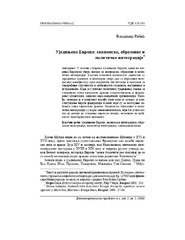Приказ основних података о документу
Ujedinjena Evropa - ekonomske, obrazovne i političke integracije
United Europe: Economic, educational, and political integrations
| dc.creator | Ribić, Vladimir | |
| dc.date.accessioned | 2021-10-12T10:39:20Z | |
| dc.date.available | 2021-10-12T10:39:20Z | |
| dc.date.issued | 2006 | |
| dc.identifier.issn | 0353-1589 | |
| dc.identifier.uri | http://reff.f.bg.ac.rs/handle/123456789/585 | |
| dc.description.abstract | U osnovi stvaranja ujedinjene Evrope, odnosno širenja Evropske unije, nalaze se ekonomske, obrazovne i političke integracije. Ključni elementi ekonomskog jedinstva su zajedničko tržište i monetarna unija, dok se obrazovne integracije manifestuju kroz zajedničke institucije i programe za unapređenje stručnosti i mobilnosti studenata, nastavnika i istraživača. Kada je u pitanju političko ujedinjenje, težnja za stvaranjem unije evropskih država suprotstavljena je formiranju atlantskih, odnosno evro-američkih organizacija. Takođe, značajan je i konflikt između onih koji se zalažu za konstituisanje čvrste federacije i onih koji su za postojanje labavije unije evropskih država. Ekonomske, obrazovne i političke integracije su izraz pannacionalizma, čiji bi uspeh mogao da dovede do stvaranja evropske nacije zasnovane na građansko-teritorijalnom principu. | sr |
| dc.description.abstract | Initial political steps towards unification of European nations on level terms, i.e. on non-hegemony terms, were made within the period between the two World Wars. These endeavour's culminated with The Treaty establishing the European Coal and Steel Community (ECSC), which was signed on 18 April 1951 in Paris by France, West Germany, Italy, Belgium, Netherlands, and Luxemburg. The Treaty of Rome, establishing the European Economic Community (EEC) and the European Atomic Energy Community (Euratom), signed in Rome on 25 March 1957 broadened the economic integrations, and finally the Maastricht Treaty signed on December 1992 envisaged the establishment of economical and monetary union. Economical unification was followed by integration processes in the field of education that were manifested in joint institutions and projects for improving the expertise and mobility of students, teachers and researchers. As far as the political integration of Europe is concerned divergent directions occurred after the World War II: the first, streaming towards the establishment of the union of European nations, while the second was reflected in founding of Atlantic, namely Euro-Atlantic organizations. Furthermore, there has been a constant struggle ever since between those advocating a tighter federation and those wishing a looser union of European states. Political integration is followed by attempts to create a fundamentally joint European identity based on mutual cultural heritage. Economic, educational, and political integrations within the framework of European Union are an expression of pan-national aspirations, which could if successful - result in establishment of a single European nation, founded on the civil-territorial principle. | en |
| dc.publisher | Univerzitet u Beogradu - Filozofski fakultet - Odeljenje za etnologiju i antropologiju, Beograd | |
| dc.relation | info:eu-repo/grantAgreement/MESTD/MPN2006-2010/147035/RS// | |
| dc.rights | openAccess | |
| dc.rights.uri | https://creativecommons.org/licenses/by/4.0/ | |
| dc.source | Etnoantropološki problemi | |
| dc.subject | ujedinjena Evropa | sr |
| dc.subject | političke integracije | sr |
| dc.subject | pannacionalizam | sr |
| dc.subject | obrazovne integracije | sr |
| dc.subject | ekonomske integracije | sr |
| dc.title | Ujedinjena Evropa - ekonomske, obrazovne i političke integracije | sr |
| dc.title | United Europe: Economic, educational, and political integrations | en |
| dc.type | article | |
| dc.rights.license | BY | |
| dc.citation.epage | 79 | |
| dc.citation.issue | 1 | |
| dc.citation.other | 1(1): 61-79 | |
| dc.citation.spage | 61 | |
| dc.citation.volume | 1 | |
| dc.identifier.fulltext | http://reff.f.bg.ac.rs/bitstream/id/2111/582.pdf | |
| dc.identifier.rcub | https://hdl.handle.net/21.15107/rcub_reff_585 | |
| dc.type.version | publishedVersion |

